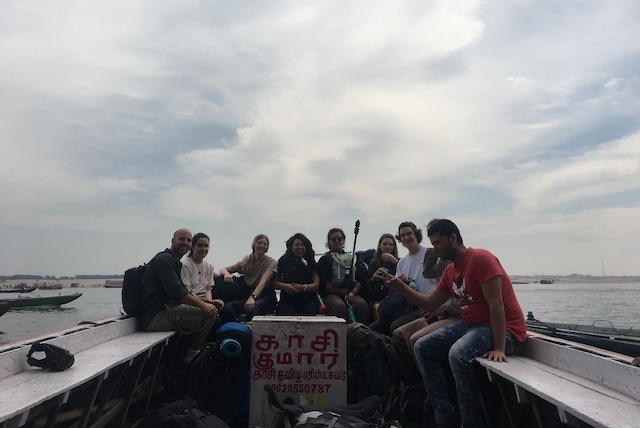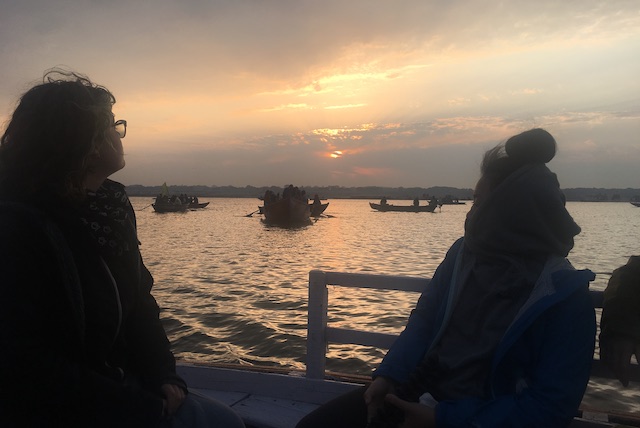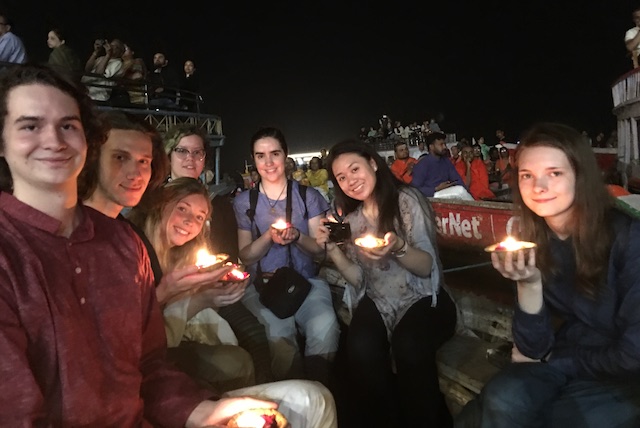Written By Zevi
Namaste to all!
I, Zevi, from Portland, Oregon and 18 years old, have received the job to share our Shanti groups’ wonderful experience in Varanasi, the spiritual capital of India! I know everyone says that there are countless unforgettable memories of when they travel places, but our experience in Varanasi truly was exactly that: filled with countless unforgettable memories, positive, powerful, and eye opening.
For starters, the 6pm-8am 14 hour expected train ride to Varanasi from Delhi took an extra 3 or so hours, due to who knows what. Maybe there was a cow on the tracks. Just kidding! (Not really, it is quite possible). Anyways, although the train was cramped, I had fun talking with Adam, Charlotte and Georgia, who were in the same section as me, about languages (mostly Hindi), religion and travel while getting to know each other a little better. In the morning, I played card games with a couple young Indian men, 20 and 23, who were very friendly and funny, helping to pass the time.
We finally arrived in Varanasi!
To give you a taste of Varanasi, it is said that “if you don’t visit Varanasi, you don’t visit India.” Now, take a second and close your eyes and picture crazy, beautiful, hectic, jaw-dropping India, then open your eyes. That’s what Varanasi was like. Constant honking of horns coming from motorcycles, cars, tuk tuks (little 3-wheeled taxis), bicycles, and cows (get it because some of them have horns) filled our ears from every direction. The only rule of the road in India is to get home safely. All vehicles and pedestrians are always going in every direction crossing and/or driving on the street, and yet no one gets hit. There is no such thing as a “wrong way.” There is no such thing as lanes. 99% of the time, vehicles are 5 or 6 abreast across what is supposed to be a 3 lane road. Additionally, cows roam around like they own the city, dropping their special cow pies wherever they do so please, heaps of trash line the sides of the street and dust fills the air. We’ll all probably be deaf by the end of the first month. It amazes me everyday. Due to the change in the wild environment, food, lifestyle, etc. everyone has gotten sick with something at some point.
Our first hostel was located through many a twists and turns that seemed to go on forever. On the way there, I stepped in my first cow patty. Woohoo! At first I thought that it was the worst thing in the world, but Adam assured me that in a couple of hours after it dries, I won’t even notice it, and he was right. All of outside was already dirty, so it didn’t really matter. Myself and the other students slept in the same room in bunk beds that we later realized were made of Styrofoam, aka not comfortable at all. But that was the least of our concerns. We had access to a beautiful view of neighboring houses on the top of the roof of the hostel. Although, from time to time, curious monkeys would walk around the roof in search of food or an item of clothing drying on the clothesline. In fact, one time, while we were having a group meeting on the roof, a monkey hopped down from the wall and tried to steal my Indian styled shirt that I had bought a few days before that made me look oh so handsome. Luckily, I had tied the shirt, as well as all of my other clothes, to the clothesline for that exact purpose, so that the monkey couldn’t steal them. Adam came to the rescue and scared it away with a stick and it left empty handed.
One of the greatest places that we continued to go back to as a group was a little clothing store around the corner of the hostel. We all bought some item of clothing there, and are rocking the look everyday. Some more than others, such as Kari and Charlotte, really got into buying from that store. One of the men at the store even closed down the store to take the two of them around part of the city and invited them to his friend’s wedding! In India, everyone is invited to everyone’s wedding. I admit we have crashed a couple extravagant weddings already and I am sure there will be more to come (we were invited inside and danced)! It’s always funny to see the looks on Indian people’s faces when they see a bunch of foreigners wearing their style of clothing, and Owen sure gets a lot of stares because he stands proud at 6’4″. If all of us had bought the same clothes in the US, it would have been at least $100 each at the very minimum. In general, everything is far less expensive than I expected, especially the food.
I have always loved Indian food, but oh. my. gosh. The street food in Varanasi was, of course, the best Indian food any of us have ever had (maybe Rebecca has had better Indian food elsewhere in the country, given that this is her 14th time in India). Rebecca has continued to excel in ordering the group phenomenal family style meals time and time again while also teaching us what each thing is. Some of my favorites are naan, (a flat bread) and aloo gobhi curry (potato cauliflower curry) which work very well together. Speaking of working well together, Adam’s love of language works hand in hand with Rebecca’s love of food, for he uses his Hindi as much as he can to communicate with waiters and locals and the like. Even outside of the restaurants and street food, Adam and Rebecca have been truly incredible leaders through their navigation, chillness, humor, maturity, and clear demonstration of people who care about and want to help us as students have an amazing trip.
The amazing trip has thankfully only just begun, and there is so much more to share. Varanasi is known for something called the ghats, as well as the burning ghats. The literal definition of ghats are stairs that lead into a river, but in Varanasi they are so much more. Varanasi is located along the Ganges River which is where a part of the ceremonies of the burning ghats has its role. The burning ghats is a cremation of those of have died and is considered to be the holiest place in India to die. There are three tiers of where the bodies are burned, where the highest ones is where the upper class are burned, and the lowest one is where the lowest class are burned. Watching the dead bodies burn on the ghats was a very interesting experience. It almost didn’t seem real. We were standing about 50ft away from the burning bodies, but I could still see the feet hanging off the edge. That was the most eerie part for me because that was the only part of their bodies I could see. It was extremely powerful and uneasy but I am very glad that I got to see it.
Along the Ganges river, we passed many Babas, who are holy men who sleep under tarps with practically no belongings, cover themselves in ash and paint, dress in orange in red robes, (or sometimes literally nothing at all) and often have a long beard and even longer dreadlocks, some of whom have been growing them for most of their lives when they decided to become babas as kids. They are very fascinating looking people, as well as their culture, so I would recommend at some point looking up pictures of them (they may also be called sadhus). The only off part about them is that some of them have smart phones. None of us know what’s up with that.
On a much lighter note, everyone got to take various classes in Assi ghat, the section of ghats of Varanasi farthest down the river. Olivia, Owen and I took fire dancing and it was extremely fun (as well as painful). Owen and I worked with poi, a tight knot of rope connected to a chain and two loops for our finger, for each hand, and Olivia worked with a staff. Don’t worry, nobody got burned! But we all hit ourselves numerous times in numerous painful places. It was only on the last day of class that we were allowed to light our objects on fire, and that was scary at first, but very very fun and thrilling as I got used to the loud flames flying past my head and body. Amiah was brave to be the only one to take a morning class, jewelry, which meant she walked 45 minutes there and back every class. By the end, she created a professional looking frame for an opal in her necklace made of silver and copper to create sterling silver. Kari worked in the small confines of a stone making shop, creating a beautiful stone necklace with intricate designs on both sides. Georgia and Charlotte learned how to make henna from scratch and drew very nice looking designs on their hands that surely impressed me. In addition to these classes that we split up to take (unless we were with one or two others), we all took Hindi lessons together with a very friendly and wise teacher, Pinku, or Pinku Ji, which means sir. Through our 5 Hindi classes, we learned many useful vocabulary words and sentence structures and sentences. Hindi is a very hard language to learn since the verbs, adjectives, subjects etc. are all mixed up compared to English and there is a nasal tone that is used often that is hard to make.
Pinkhu Ji not only taught us Hindi, but he lead us around to a couple other cool spots in Varanasi. For instance, he lead us through Sarnath, which is where the Buddha gave his first teaching after enlightenment. He taught us about the connection between the Buddha and the wheel with 24 spokes on the Indian flag, representing the 24 parts of Buddha. He also lead us on a “saree tour” which was very informative. We got to see some of the steps of the making of sarees. The beginning involved straightening out the long strands of silk, about 40ft long. The 5 or 6 men doing this each only make about 600 rupees per day, about $8.50 US. It blows my mind how much people live off of in India and what they have and don’t have, use and don’t use.
One of the things they don’t use is toilet paper. Yup. They wipe with their left hand and use water from a cup or a bidet with their right hand. Adam has informed the group not to make the same mistake he made of paying with his left hand, for the locals will yell to take the money back and use the other hand. As far as I know, everyone in the group (except maybe Adam and Rebecca) has yet to use their hand to wipe. I might do it at some point, but so far I have only used toilet paper and the bidet, which is really useful (especially after the spicy food that I almost always get).
Well, as I said before, there have been countless amazing experiences and moments that have happened, but I could only include so many things that stuck out to me. Our group has been getting along extremely well and we became tightly knit from the first week.
Just writing this blog has made me smile as I reminisced the past few weeks. India and the people in it are treating Shanti ’19 right.
Until next time!



